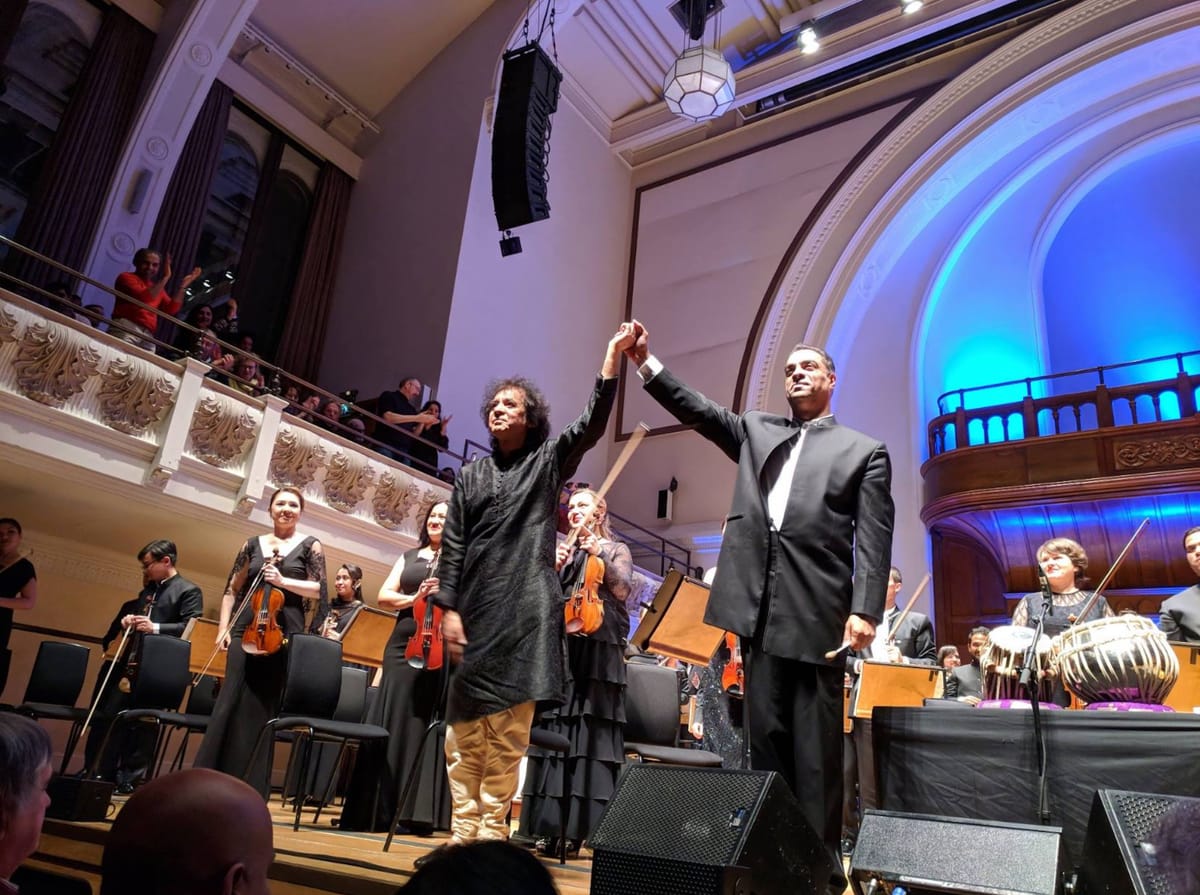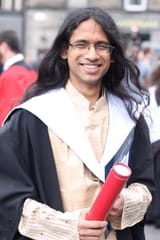ZAKIR HUSSAIN AND THE SOI TOUR CONTINUES

Symphony Orchestra of India
Cadogan Hall, London, 20 February 2019
Zane Dalal, conductor
Zakir Hussain, tabla.
Hector Berlioz, Roman Carnival Overture
Zakir Hussain, Concerto for Tabla and Orchestra ‘Peshkar’
Nikolai Rimsky-Korsakov, Scheherazade
Usher Hall, Edinburgh, 24 February 2019
Martyn Brabbins, conductor
Marat Bisengaliev, violin
Carl Maria von Weber, Oberon Overture
Max Bruch, Violin Concerto No. 1 in G
Nikolai Rimsky-Korsakov, Scheherazade
I could barely contain my excitement at the prospect of seeing Zakir Hussain perform with the Symphony Orchestra of India. I had last seen him in concert over fifteen years ago in Chennai. The centrepiece of the SOI’s first London concert was a new composition by Hussain, a Concerto for Tabla and Orchestra entitled ‘Peshkar’, taking its name from a type of composition performed at tabla recitals that introduced the many rhythming forms and devices that will be used through the rest of the recital. Hussain’s concerto featured the tabla playing abridged sections of what would be a typical peshkar in Hindustani music, introducing the rhythmic figures that are central to the piece, which the orchestra would subsequently reiterate, elaborate and colour with their melodic voices.
This kind of blending of Hindustani and Western music meant having to overcome a number of technical challenges: the balance between orchestra and tabla is impossible to achieve without speakers and accurate sound engineering to strengthen the voice of the solo instrument, especially in auditoriums whose acoustics are not suited for these instruments. Moreover, Hussain’s tablas had to adapt to the change in humidity and climate of a different country, and he even had to perform using a stand-by tabla in Birmingham. Hussain and the Orchestra made the performance seem seamless and fluid, although foregrounding these elements does pose interesting questions about what it means to make music that brings different forms together.
The performance itself was one without parallel: Hussain brought to the music his characteristic energy, playfulness and wit. This was most striking in the sections that he improvised, where he showed great flair for surprising turns of phrase. The Orchestra faced the unenviable challenge of having to respond to such vibrant and energetic playing and enter into dialogue with Hussain, something they nevertheless accomplished with great élan thanks to their sensitivity and attention. They breathed into the intricate rhythmic figures that Hussain presented a new life and colour. I thought it was rather appropriate that an ustad of such prodigious talent, who has been touring since an astonishingly young age, was performing a short walk from what was once the London house of Mozart.
Setting aside this magnificent centrepiece, the opening overture by Hector Berlioz and the closing performance of the Scheherazade showcased many of the SOI’s fine talents as well as conductor Zane Dalal’s masterful musicianship. The Orchestra presented the tender opening parts of the Berlioz overture on the woodwinds with a sensitivity and lusciousness that captured that side of Berlioz that was really effusive in the writing of delicate themes and intricate textures. The solo for the cor anglais was likewise incredibly moving, testament to how well the Orchestra got a feel for the many nuances of Berlioz’s work. Likewise for the saltarello dance in the latter half of the piece, they brought to life the revelry of the carnival with a passion and eccentricity that was true to the spirit of the composer’s idiosyncratic idiom. Just like in their encore performance of the theme from The Magnificent Seven, the Orchestra did fine work in bringing out the subtleties of the textures and rhythms of some rousing pieces.
Their concert in Edinburgh a few days after featured a different programme. The SOI, conducted by Martyn Brabbins, opens with Carl Maria von Weber’s Oberon Overture, which they presented with an appropriately light touch. Their subsequent rendition of a later Romantic piece like Max Bruch’s violin concerto was one with great expressive flair and a sensitivity to the conversational dialogue between the solo and orchestral parts. Soloist Marat Bisengaliev brought to the piece a fluidity and precision that made his playing seem effortless, even when faced with the staggering demands of the cadenzas in the opening movement or the vigorous dance in the finale.
They wrapped up both their performances with Rimsky-Korsakov’s Scheherazade. Both Dalal and Brabbins showed great attention to the dramatic tension of the piece, and their interpretation of the interplay between the Sultan’s intimidating fanfares and Scheherazade’s theme brought this to the fore. The principal players of various string and wind sections gave outstanding renditions of their respective solos, of particular note being the renowned violin solo, but also the dialogue between the bassoon and violin in the second movement which the players sang with great intimacy and tenderness.
It was an immense pleasure to see the Scheherazade performed twice in such quick succession, matched only by how great my fortune was that I could see Hussain perform with the SOI down in London.





